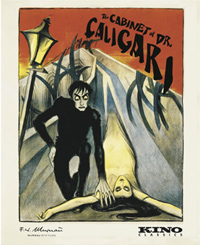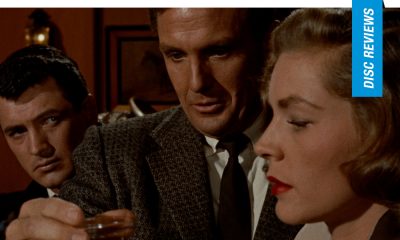Disc Reviews
The Cabinet of Dr. Caligari | Blu-ray Review
 Kino Classics refurbishes Robert Weine’s 1920 landmark title The Cabinet of Dr. Caligari, the film that marked the birth of German Expressionism as well as the flagship of the horror film genre. Tempered by bookends meant to diminish interpretations of parallelism between insanity and authority, its stark, jagged angles and ingenious uses of shadows predates the dark beauty of film noir, featuring fantastic set designs that still rival the ability of contemporary film. Eerie, carnivalesque, and as arresting as ever, it’s a title worthy of this remastered revisit.
Kino Classics refurbishes Robert Weine’s 1920 landmark title The Cabinet of Dr. Caligari, the film that marked the birth of German Expressionism as well as the flagship of the horror film genre. Tempered by bookends meant to diminish interpretations of parallelism between insanity and authority, its stark, jagged angles and ingenious uses of shadows predates the dark beauty of film noir, featuring fantastic set designs that still rival the ability of contemporary film. Eerie, carnivalesque, and as arresting as ever, it’s a title worthy of this remastered revisit.
The story of Caligari, developed by Carl Mayer (responsible for Murnau’s Sunrise and The Last Laugh) and Hans Janowitz, is incredibly simple. Basically, the eponymous doctor happens to have control of a sleepwalker that does nefarious deeds for his master, namely murdering inhabitants of the small hamlet late at night. There is a slight twist to the proceedings, though it tends to seem more of a cop out. What remains most fascinating about the title to this day is the unique ambience its design still manages to maintain, it’s angular and jagged depiction of the small town of Holstenwall looming into our view like some perverse rendering of a Dr. Seuss nightmare. As the somnambulist, Conrad Veidt, who would go on to major stardom in a variety of films, including Casablanca (1942), isn’t given much to do, his major moment being one of the few close-ups granted of his face when he’s first introduced and ‘awakened’ for the audience, his skeleton frame predicting the fate of a man he will murder later that night. Instead it’s Werner Krauss as Caligari that gnashes his furiously overworked visage that holds our attention, almost like a mad hatter version of Emil Janning in The Blue Angel (1930). Lil Dagover, who would appear in Lang’s first major work in the German Expressionism movement, Destiny (1921), seems more of an afterthought, a puppet lost in the scheme, but made necessary by the introduction of the framed narrative.
Disc Review
Previously available from Kino, as well as a variety of other formats, including from Alphavideos due to the lapse into public domain, this is the best transfer to date of Weine’s important title. Sickly green intertitles, relayed in German with English subtitles, add to the film’s vibrant visuals.
Caligari: How Horror Came to the Cinema
A fifty two minute documentary charts the historical elements that contributed to the birth of Dr. Caligari.
Image Restoration
Kino includes two side by side frames to show how impressive the restoration of the film looks.
Final Thoughts
While its importance in the cinematic canon is generally in its reference to the German Expressionism movement, it’s important to remember that Caligari was also the reason that bans against German cinema were lifted in various countries following World War I. While Weine, who fled Nazi Germany in WWII, would make a total of 47 features, it is only Caligari (remade in 1962 starring Glynis Johns) and a 1924 feature, The Hands of Orlac (reuniting Weine with Veidt, and also sparking a rash of remakes, two of which would star Peter Lorre) that continue to be regularly discussed. To today’s audiences, the title surely seems simplistic and even banal, yet it evokes a strangeness with its bizarre visuals that still manages to lodge in one’s mind. It’s easy to see how Weine influenced generations of filmmakers, including the earlier, inspired works of Tim Burton.
Film: ★★★★/☆☆☆☆☆
Disc: ★★★★/☆☆☆☆☆


































